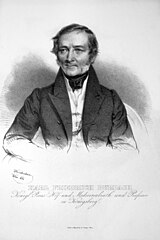Friedrich Burdach

| |
| Data i miejsce urodzenia | |
|---|---|
| Data i miejsce śmierci | |
| profesor nauk medycznych | |
| Specjalność: neuroanatomia | |
| Alma Mater | |
| Profesura | |
| Nauczyciel akademicki | |
| Uczelnia | |
| Rektor Uniwersytetu w Królewcu | |
Karl Friedrich Burdach (ur. 12 czerwca 1776 w Lipsku, zm. 16 lipca 1847 w Królewcu) – niemiecki lekarz neuroanatom, fizjolog, historyk neuroanatomii.
Życiorys
[edytuj | edytuj kod]Burdach studiował medycynę na Uniwersytecie Lipskim. Ukończył studia w 1800 roku i w 1811 roku został profesorem fizjologii na Uniwersytecie w Dorpacie. Cztery lata później objął katedrę fizjologii na Uniwersytecie Albrechta w Królewcu w semestrze zimowym 1829-1830, oraz w 1841 i 1844 był rektorem uczelni.
Jego syn, Ernst Burdach (1801–1876), również był anatomem.
Dorobek naukowy
[edytuj | edytuj kod]Jako jeden z pierwszych opisał pęczek łukowaty[1]. W 1826 opisał pęczek klinowaty, zwany na jego cześć także pęczkiem Burdacha[2]. W swoim dziele z 1822 wprowadził do neuroanatomii terminy przedmurza (niem. Vormauer, łac. claustrum), jądra soczewkowatego, skorupy, poduszki, torebki zewnętrznej i wewnętrznej, jądra migdałowatego, jądra czerwiennego, blaszki krańcowej, płaszcza, kory obręczy, obręczy (cingulum), podkładki (subiculum), koryta (alveus), klinka (cuneus) i przedklinka (precuneus)[3].
Za sprawą swoich starannych opracowań neuroanatomicznych, w których odwoływał się do prac poprzedników (m.in. Thomasa Willisa), określany jest także jako historyk neuroanatomii[4].
W 1800 roku wprowadził terminy „morfologia” i „biologia”. To ostatnie często nieprawidłowo przypisuje się Treviranusowi lub Lamarckowi.
Wybrane prace
[edytuj | edytuj kod]- Asklepiades und John Brown: eine Parallele. Leipzig: G.B. Meissner, 1800
- Handbuch der Pathologie. Leipzig 1808
- Der Organismus menschlicher Wissenschaft und Kunst. Leipzig 1809
- Encyklopädie der Heilwissenschaft. Leipzig: Mitzky
- Die Literatur der Heilwissenschaft. Gotha: Perthes, 1810
- Auflösung eines Räthsels vom Essig. Dorpat, 1813
- Anatomische Untersuchungen: bezogen auf Naturwissenschaft und Heilkunst. Leipzig: Hartmann, 1814
- Vom Baue und Leben des Gehirns. Leipzig: Dyk.
- Beschreibung des untern Theils des Rückenmarks. W: Konigsberg, Königliche Anatomische Anstalt. Berichte, etc. no. 1. 1818
- Bemerkungen über den Mechanismus der Herzklappen. W: Konigsberg, Königliche Anatomische Anstalt. Berichte, etc. no. 3. 1820
- Ansichten des Elektro-Magnetismus. W: Konigsberg, Königliche Anatomische Anstalt. Berichte, etc. no. 5. 1822
- Die Physiologie als Erfahrungswisssenschaft. Leipzig: Voß. 6 Bände. 1826–1840
- Historisch-statistische Studien über die Cholera-Epidemie vom Jahre 1831. Königsberg 1832
- Der Mensch nach den verschiedenen Seiten seiner Natur. Anthropologie für das gebildete Publicum. Stuttgart 1837
- Gerichtsärztliche Arbeiten. 1. Bd. Stuttgart und Tübingen: Cotta'schen Bhdlg., 1839
- Blicke ins Leben. 1842–1848
- Rückblick auf mein Leben. Leipzig: Voß, 1848
Przypisy
[edytuj | edytuj kod]- ↑ M Catani, M Mesulam. The arcuate fasciculus and the disconnection theme in language and aphasia: history and current state. „Cortex”. 44 (8), s. 953-61, wrzesień 2008. DOI: 10.1016/j.cortex.2008.04.002. PMID: 18614162.
- ↑ Pearce JM. Burdach′s column. „European Neurology”. 55. 3, s. 179-80, 2006. DOI: 10.1159/000093580. PMID: 16733361.
- ↑ Meyer A. Karl Friedrich Burdach and his place in the history of neuroanatomy. „Journal of Neurology, Neurosurgery & Psychiatry”. 33. 5, s. 553-61, 1971. PMID: 4922393.
- ↑ A. Meyer, T. Willis, KF. Burdach. Karl Friedrich Burdach on Thomas Willis. „Journal of the Neurological Sciences”. 3 (2), s. 109-16, 1966. DOI: 10.1016/0022-510X(66)90054-2. PMID: 5328362.
Text is available under the CC BY-SA 4.0 license; additional terms may apply.
Images, videos and audio are available under their respective licenses.
